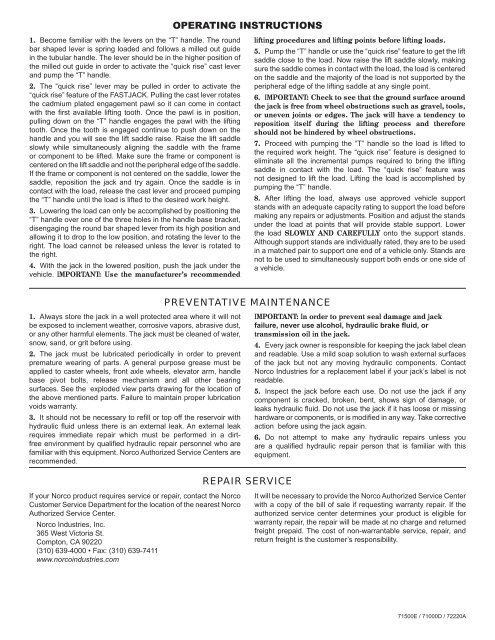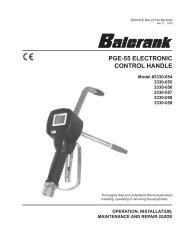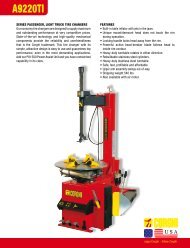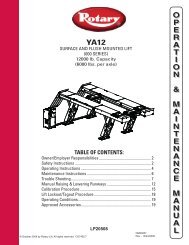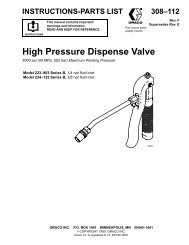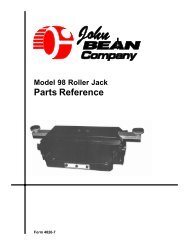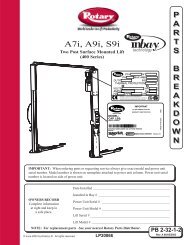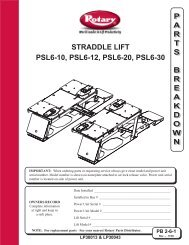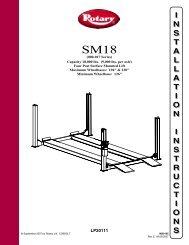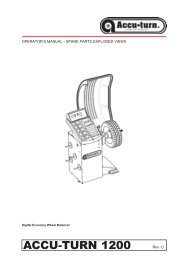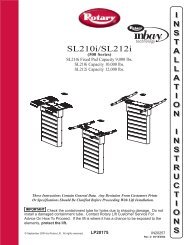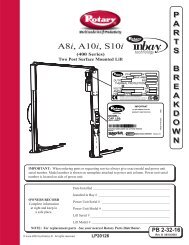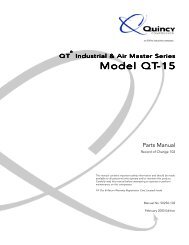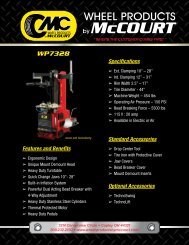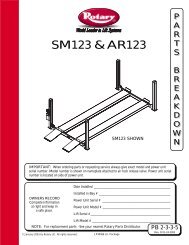models 71500e 5 ton, 71000d 10 ton, & 72220a 20 ton capacity ...
models 71500e 5 ton, 71000d 10 ton, & 72220a 20 ton capacity ...
models 71500e 5 ton, 71000d 10 ton, & 72220a 20 ton capacity ...
You also want an ePaper? Increase the reach of your titles
YUMPU automatically turns print PDFs into web optimized ePapers that Google loves.
1. Become familiar with the levers on the “T” handle. The round<br />
bar shaped lever is spring loaded and follows a milled out guide<br />
in the tubular handle. The lever should be in the higher position of<br />
the milled out guide in order to activate the “quick rise” cast lever<br />
and pump the “T” handle.<br />
2. The “quick rise” lever may be pulled in order to activate the<br />
“quick rise” feature of the FASTJACK. Pulling the cast lever rotates<br />
the cadmium plated engagement pawl so it can come in contact<br />
with the first available lifting tooth. Once the pawl is in position,<br />
pulling down on the “T” handle engages the pawl with the lifting<br />
tooth. Once the tooth is engaged continue to push down on the<br />
handle and you will see the lift saddle raise. Raise the lift saddle<br />
slowly while simultaneously aligning the saddle with the frame<br />
or component to be lifted. Make sure the frame or component is<br />
centered on the lift saddle and not the peripheral edge of the saddle.<br />
If the frame or component is not centered on the saddle, lower the<br />
saddle, reposition the jack and try again. Once the saddle is in<br />
contact with the load, release the cast lever and proceed pumping<br />
the “T” handle until the load is lifted to the desired work height.<br />
3. Lowering the load can only be accomplished by positioning the<br />
“T” handle over one of the three holes in the handle base bracket,<br />
disengaging the round bar shaped lever from its high position and<br />
allowing it to drop to the low position, and rotating the lever to the<br />
right. The load cannot be released unless the lever is rotated to<br />
the right.<br />
4. With the jack in the lowered position, push the jack under the<br />
vehicle. IMPORTANT: Use the manufacturer’s recommended<br />
1. Always store the jack in a well protected area where it will not<br />
be exposed to inclement weather, corrosive vapors, abrasive dust,<br />
or any other harmful elements. The jack must be cleaned of water,<br />
snow, sand, or grit before using.<br />
2. The jack must be lubricated periodically in order to prevent<br />
premature wearing of parts. A general purpose grease must be<br />
applied to caster wheels, front axle wheels, elevator arm, handle<br />
base pivot bolts, release mechanism and all other bearing<br />
surfaces. See the exploded view parts drawing for the location of<br />
the above mentioned parts. Failure to maintain proper lubrication<br />
voids warranty.<br />
3. It should not be necessary to refill or top off the reservoir with<br />
hydraulic fluid unless there is an external leak. An external leak<br />
requires immediate repair which must be performed in a dirtfree<br />
environment by qualified hydraulic repair personnel who are<br />
familiar with this equipment. Norco Authorized Service Centers are<br />
recommended.<br />
If your Norco product requires service or repair, contact the Norco<br />
Customer Service Department for the location of the nearest Norco<br />
Authorized Service Center.<br />
Norco Industries, Inc.<br />
365 West Victoria St.<br />
Comp<strong>ton</strong>, CA 902<strong>20</strong><br />
(3<strong>10</strong>) 639-4000 • Fax: (3<strong>10</strong>) 639-7411<br />
www.norcoindustries.com<br />
OPERATING INSTRUCTIONS<br />
PREVENTATIVE MAINTENANCE<br />
REPAIR SERVICE<br />
lifting procedures and lifting points before lifting loads.<br />
5. Pump the “T” handle or use the “quick rise” feature to get the lift<br />
saddle close to the load. Now raise the lift saddle slowly, making<br />
sure the saddle comes in contact with the load, the load is centered<br />
on the saddle and the majority of the load is not supported by the<br />
peripheral edge of the lifting saddle at any single point.<br />
6. IMPORTANT: Check to see that the ground surface around<br />
the jack is free from wheel obstructions such as gravel, tools,<br />
or uneven joints or edges. The jack will have a tendency to<br />
reposition itself during the lifting process and therefore<br />
should not be hindered by wheel obstructions.<br />
7. Proceed with pumping the “T” handle so the load is lifted to<br />
the required work height. The “quick rise” feature is designed to<br />
eliminate all the incremental pumps required to bring the lifting<br />
saddle in contact with the load. The “quick rise” feature was<br />
not designed to lift the load. Lifting the load is accomplished by<br />
pumping the “T” handle.<br />
8. After lifting the load, always use approved vehicle support<br />
stands with an adequate <strong>capacity</strong> rating to support the load before<br />
making any repairs or adjustments. Position and adjust the stands<br />
under the load at points that will provide stable support. Lower<br />
the load SLOWLY AND CAREFULLY onto the support stands.<br />
Although support stands are individually rated, they are to be used<br />
in a matched pair to support one end of a vehicle only. Stands are<br />
not to be used to simultaneously support both ends or one side of<br />
a vehicle.<br />
IMPORTANT: In order to prevent seal damage and jack<br />
failure, never use alcohol, hydraulic brake fluid, or<br />
transmission oil in the jack.<br />
4. Every jack owner is responsible for keeping the jack label clean<br />
and readable. Use a mild soap solution to wash external surfaces<br />
of the jack but not any moving hydraulic components. Contact<br />
Norco Industries for a replacement label if your jack’s label is not<br />
readable.<br />
5. Inspect the jack before each use. Do not use the jack if any<br />
component is cracked, broken, bent, shows sign of damage, or<br />
leaks hydraulic fluid. Do not use the jack if it has loose or missing<br />
hardware or components, or is modified in any way. Take corrective<br />
action before using the jack again.<br />
6. Do not attempt to make any hydraulic repairs unless you<br />
are a qualified hydraulic repair person that is familiar with this<br />
equipment.<br />
It will be necessary to provide the Norco Authorized Service Center<br />
with a copy of the bill of sale if requesting warranty repair. If the<br />
authorized service center determines your product is eligible for<br />
warranty repair, the repair will be made at no charge and returned<br />
freight prepaid. The cost of non-warrantable service, repair, and<br />
return freight is the customer’s responsibility.<br />
71500E / 7<strong>10</strong>00D / 722<strong>20</strong>A


